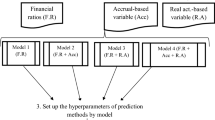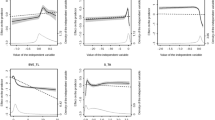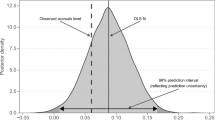Abstract
Financial information has been widely used to design bankruptcy prediction models. All research works that have studied such models assume that financial statements are reliable. However, reality is a bit different. Indeed, firms may tend to present their financial accounts depending on particular circumstances, especially when seeking to change the perception of the risk incurred by their partners, and thus distort or alter some of them. Consequently, one may wonder to what extent such “manipulations”, called earnings management, may influence any model that relies on accounting data. This is why we study how earnings management may affect financial variables and how it can indirectly distort predictions made by failure models. For this purpose, we used a measure that makes it possible to assess potential account manipulations, and not effective manipulations. Our results show that when these distortions are measured and used with other financial variables, models are more accurate than those that solely rely on pure financial data. They also show that the improvement of model accuracy is essentially due to a reduction of type-I error—the costliest error in economic terms.
Similar content being viewed by others
Notes
When we estimate ROA, we use net income rather than net income plus net-of-tax interest expense (the traditional measure used to calculate ROA) to avoid potential problems associated with the estimation of a tax rate.
References
Adu-Boateng, D. (2011). A theoretical construct for explaining the impact of financial distress on unethical earnings management decisions. Journal of American Academy of Business, 16(2), 89–95.
Altman, E. I. (1968). Financial ratios, discriminant analysis and the prediction of corporate bankruptcy. Journal of Finance, 23(4), 589–609.
Altman, E. I., Haldeman, R., & Narayanan, P. (1977). Zeta analysis: A new model to identify bankruptcy risk of corporations. Journal of Banking and Finance, 1(1), 29–51.
Atiya, A. F. (2001). Bankruptcy prediction credit risk using neural networks: A survey and new results. IEEE Transactions on Neural Networks, 12, 929–935.
Barber, B., & Lyon, J. (1996). Detecting abnormal operating performance: The empirical power and specification of test statistic. Journal of Financial Economics, 41(2), 359–399.
Bardos, M. (1998). Detecting the risk of company failure at the Banque de France. Journal of Banking and Finance, 22, 1405–1419.
Bardos, M. (2003). Scoring sur données d’entreprises : Instrument de diagnostic individuel et outil d’analyse de portefeuille d’une clientèle. Romuald, 38, 159–177.
Bardos, M. (2008). Scoring sur données d’entreprises : Instrument de diagnostic individuel et outil d’analyse de portefeuille d’une clientèle. Romuald, 38, 159–177.
Barniv, R., Agarwal, A., & Leach, R. (1997). Predicting the outcome following bankruptcy filing: A three-state classification using neural networks. International Journal of Intelligent Systems in Accounting, Finance and Management, 6(3), 177–194.
Barniv, R., & Hershbarger, A. (1990). Classifying financial distress in the life insurance industry. Journal of Risk and Insurance, 57(1), 110–136.
Beaver, W. H. (1966). Financial ratios as predictors of failure, empirical research in accounting, selected studies. Journal of Accounting Research, 4, 71–111.
Beaver, W. H. (1968). Market price, financial ratios and the prediction of failure. Journal of Accounting Research, 6(2), 179–192.
Beynon, M. J., & Peel, M. J. (2001). Variable precision rough set theory and data discretisation: An application to corporate failure prediction. Omega International Journal of Management Science, 29(6), 561–576.
Bergstresser, D., & Philippon, T. (2006). CEO incentives and earnings management. Journal of Financial Economics, 80(3), 511–529.
Booth, P. J. (1983). Decomposition measure and the prediction of financial failure. Journal of Business Finance and Accounting, 10(1), 67–82.
Boser, B. E., Guyon, I. M., & Vapnik, V. N. (1992). A training algorithm for optimal margin classifiers. In Proceedings of the 5th annual ACM workshop on computational learning theory (pp. 144–152). ACM Press.
Breiman, L. (1996). Bagging predictors. Machine Learning, 24(2), 123–140.
Burgstahler, D., & Dichev, I. (1997). Earnings management to avoid earnings decreases and losses. Journal of Accounting and Economics, 21(1), 99–126.
Campa, D., & Camacho-Minano, M. (2015). The impact of SME’s pre-bankruptcy financial distress on earnings management tools. International Review of Financial Analysis, 42, 222–234.
Charitou, A., Lambertides, N., & Trigeorgis, L. (2007). Managerial discretion in distressed firms. The Accounting Review, 39(4), 323–346.
d’Argenti, J. (1976). Corporate collapse: The causes and the symptoms. London: Mc Graw Hill.
Dambolena, I. G., & Khoury, S. J. (1980). Ratios stability and corporate failure. Journal of Finance, 35(4), 1017–1026.
DeAngelo, L. (1986). Accounting numbers as market valuation substitutes: A study of management buyouts of public stockholders. The Accounting Review, 61(3), 400–420.
DeAngelo, H., DeAngelo, L., & Skinner, D. J. (1994). Accounting choice in troubled companies. Journal of Accounting and Economics, 17(1–2), 113–143.
Dechow, P. M., Sloan, R. G., & Sweeney, A. P. (1995). Detecting earnings management. The Accounting Review, 70(2), 193–225.
DeFond, M., & Jiambalvo, J. (1994). Debt covenant violations and manipulation of accruals. Journal of Accounting and Economics, 17(1–2), 145–176.
Degeorge, F., Patel, J., & Zeckhauser, R. (1999). Earnings management to exceed thresholds. Journal of Business, 72(1), 1–35.
Dichev, I. D., & Skinner, D. J. (2002). Large-sample evidence on the debt covenant hypothesis. Journal of Accounting Research, 40(4), 1091–1103.
Dimitras, A., Zanakis, S., & Zopoudinis, C. (1996). A survey of business failures with an emphasis on failure prediction methods and industrial application. European Journal of Operational Research, 90(3), 487–513.
du Jardin, P. (2015). Bankruptcy prediction using terminal failure processes. European Journal of Operational Research, 242, 286–303.
du Jardin, P. (2016). A two-stage classification technique for bankruptcy prediction. European Journal of Operational Research, 254, 236–252.
Franceschetti, B. M., & Koschtial, C. (2013). Do bankrupt companies manipulate earnings more than the non-bankrupt ones? Journal of Finance and Accountancy, 12, 4–25.
Freund, Y. (1990). Boosting a weak learning algorithm by majority. In COLT ’90 Proceedings of the third annual workshop on Computational learning theory (pp. 202–216). San Francisco: Morgan Kaufmann Publishers Inc.
Frydman, H., Altman, E. I., & Kao, D. (1985). Introducing recursive partitioning for financial classification: The case of financial distress. Journal of Finance, 40(1), 269–291.
Gentry, J. A., Newbold, P., & Whitford, D. T. (1987). Funds flow components, financial ratios and bankruptcy. Journal of Business Finance and Accountancy, 14, 595–606.
Grandvallet, Y. (2001). Bagging can stabilize without reducing variance. In International conference on artificial neural networks (pp. 49–56). Vienna, Austria.
Grice, J. S., & Dugan, M. T. (2003). Reestimations of the Zmijewski and Ohlson bankruptcy prediction models. Advances in Accounting, 20, 77–93.
Healy, P. M. (1985). The effect of bonus schemes on accounting decisions. Journal of Accounting and Economics, 7, 85–107.
Healy, P. M., & Wahlen, J. M. (1999). A review of the earnings management literature and its applications for standard settings. Accounting Horizon, 13(4), 365–383.
Hornik, K., Stinchombe, M., & White, H. (1990). Universal approximation of an unknown mapping and its derivatives using multilayer feedforward networks. Neural Networks, 3(5), 551–560.
Huang, C. S., Dorsey, R. E., & Boose, M. A. (1994). Life insurer financial distress prediction: A neural network model. Journal of Insurance Regulation, 3(2), 131–167.
Huang, G. B., Zhu, Q. Y., & Siew, C. K. (2006). Extreme Learning machine: Theory and applications. Neurocomputing, 70(1), 489–501.
Ikenberry, D., Lakonishok, J., & Vermaelen, T. (1995). Market underreaction to open market share repurchases. Journal of Financial Economics, 39(2), 181–208.
Jones, J. (1991). Earnings management during import relief investigations. Journal of Accounting Research, 29(2), 193–228.
Jones, S., & Hensher, D. A. (2004). Modelling corporate failure: A multinomial nested logit analysis for unordered outcomes. British Accounting Review, 39(1), 89–107.
Kallunki, J. P., & Martikainen, T. (1999). Financial failure and managers’ accounting responses: Finnish evidence. Journal of Multinational Financial Management, 9(1), 15–16.
Kaplan, R. S. (1985). Evidence on the effect of bonus schemes on accounting procedure and accrual decisions. Journal of Accounting and Economics, 7(1–3), 109–113.
Keasey, K., & Watson, R. (1987). Non-financial symptoms and the prediction of small company failure: A test of Argenti’s hypothesis. Journal of Business Finance and Accounting, 14(3), 335–354.
Kothari, S. P., Leone, A. J., & Wasley, C. E. (2005). Performance matched discretionary accrual measures. Journal of Accounting and Economics, 39(1), 163–197.
Kuncheva, L. I., & Whitaker, C. J. (2003). Measures of diversity in classifier ensembles and their relationship with the ensemble accuracy. Machine Learning, 51, 181–207.
Laitinen, T. (1991). Financial ratios and different failure processes. Journal of Business Finance and Accounting, 18, 649–673.
Laitinen, E. K., & Laitinen, T. (1998). Cash Management behavior and failure prediction. Journal of Business Finance and Accounting, 25(7–8), 893–919.
Laitinen, E. K., & Laitinen, T. (2000). Bankruptcy prediction : Application of the Taylor’s expansion in logistic regression. International Review of Financial Analysis, 9, 327–349.
Lara, J. M. G., Osm, B. G., & Neophytou, E. (2009). Earnings quality in ex-post failed firms. Accounting and Business Research, 39(2), 119–138.
Lee, K. C., Han, I., & Kwon, Y. (1996). Hybrid neural network models for bankruptcy predictions. Decision Support Systems, 18(1), 63–72.
Lee, T. S. (2004). Incorporating financial ratios and intellectual capital in bankruptcy predictions. In Proceedings of the National Taiwan University International Conference in Finance, Taiwan, December 20–21.
Lelogeais, L. (2003). Un score sur variables qualitatives pour la détection précoce des défaillances d’entreprises. Bulletin de la Banque de France, 114, 20–46.
Lendasse, A., Akusok, A., Simula, O., Corona,F., Van Heeswijk, M., & Eirola, E. (2013). Extreme learning machine: A robust modeling technique? In Proceedings of the 12th international conference on Artificial Neural Networks: Advances in computational intelligence.
Lennox, C. (1999). Identifying failing companies: A re-evaluation of the logit, probit and DA approaches. Journal of Economics and Business, 51(4), 347–364.
Lensberg, T., Eilifsen, A., & McKee, T. E. (2006). Bankruptcy theory development and classification via genetic programming. European Journal of Operational Research, 169, 677–697.
Leshno, M., & Spector, Y. (1996). Neural network prediction analysis: The bankruptcy case. Neurocomputing, 10, 125–147.
Lussier, R. N. (1995). A nonfinancial business success versus failure prediction model for young firms. Journal of Small Business Management, 33(1), 8–20.
Lussier, R. N., & Halabi, C. E. (2010). A three-country comparison of the business success versus failure prediction model. Journal of Small Business Management, 48(3), 360–377.
McNichols, M. (2000). Research design issues in earnings management studies. The Journal of Accounting and Public Policy, 19, 313–345.
Mossman, C. E., Bell, G. G., Swartz, L. M., & Turtle, H. (1998). An empirical comparison of bankruptcy models. Financial Review, 33(2), 35–53.
Mensah, Y. M. (1984). An examination of the stationarity of multivariate bankruptcy prediction models: A methodological study. Journal of Accounting Research, 22, 380–395.
Min, J. H., & Lee, Y. C. (2004). Business failure prediction with support vector machines and neural networks: A comparative study. In Proceedings of the 9th Asia–Pacific decision sciences institute conference, Seoul, Korea.
Nelson, K. (2000). Rate regulation, competition and loss reserve discounting by property-casualty insurers. The Accounting Review, 75(1), 115–138.
Ohlson, J. A. (1980). Financial ratios and the probabilistic prediction of bankruptcy. Journal of Accounting Research, 18(1), 109–131.
Ooghe, H., & Joos, P. (1990). Failure prediction, explanation of misclassifications and incorporation of other relevant variables: Result of empirical research in Belgium, working paper, Department of Corporate Finance, Ghent University, Belgium.
Peasnell, K. V., Pope, P. F., & Young, S. (2000). Detecting earnings management using cross-sectional abnormal accruals models. Accounting and Business Research, 30(4), 313–326.
Perry, S. E., & Williams, T. H. (1994). Earnings management preceding management buyout offers. Journal of Accounting and Economics, 18(2), 157–179.
Petroni, K. R., Ryan, S. G., & Wahlen, J. M. (2000). Discretionary and non-discretionary revisions of loss reserves by property-casualty insurers: Differential implications for future profitability, risk and market value. Review of Accounting Studies, 5(2), 95–125.
Platt, H. D., & Platt, M. B. (1990). Development of a class of stable predictive variables: The case of bankruptcy prediction. Journal of Business Finance and Accounting, 17(1), 31–51.
Pompe, P. P. M., & Bilderbeek, J. (2005). Bankruptcy prediction: The Influence of the year prior to failure selected for model building and the effects in a period of economic decline. International Journal of Intelligent Systems in Accounting, Finance and Management, 13(6), 95–112.
Rosner, R. L. (2003). Earnings manipulation in filing firms. Contemporary Accounting Research, 20(2), 361–408.
Schapire, R. E. (1990). The strength of weak learnability. Machine Learning, 5(2), 197–227.
Schipper, K. (1989). Commentary on earnings management. Accounting Horizons, 3(4), 91–102.
Shin, K. S., Lee, T. S., & Kim, H. J. (2005). An application of support vector machines in bankruptcy prediction model. Expert Systems with Applications, 28(1), 127–135.
Stein, R. M. (2007). Benchmarking default prediction models: Pitfalls and remedies in model validation. Journal of Risk Model Validation, 1(1), 77–113.
Sun, L., Ettredge, M., & Srivastava, R. P. (2005). A further investigation on the bankruptcy probability of firms with unhealthy Z-score. In Proceedings of the 13th annual conference on pacific basin finance, economics and accounting, June 10–11, New Jersey.
Sung, T. K., Chang, N., & Lee, G. (1999). Dynamic of modeling in data mining: Interpretive approach to bankruptcy prediction. Journal of Management Information Systems, 16(1), 63–85.
Sweeney, A. M. (1994). Debt-covenant violations and managers’ accounting responses. Journal of Accounting and Economics, 17(3), 281–308.
Tirapat, S., & Nittayagasetwat, A. (1999). An investigation of thai listed firms’ financial distress using macro and micro variables. Multinational Finance Journal, 3(2), 103–125.
Watts, R. L., & Zimmerman, J. L. (1990). Positive accounting theory: A ten-year perspective. The Accounting Review, 65(1), 131–156.
Wilson, N., Chong, K. S., & Peel, M. J. (1995). Neural network simulation and the prediction of corporate outcomes: Some empirical findings. International Journal of the Economics of Business, 2(1), 31–50.
Wu, C. H., Tzeng, G. H., Goo, Y. J., & Fang, W. C. (2007). A real-valued genetic algorithm to optimize the parameters of support vector machine for predicting bankruptcy. Expert Systems with Applications, 32(2), 397–408.
Yang, Z. R., Platt, M. B., & Platt, H. D. (1999). Probabilistic neural networks in bankruptcy prediction. Journal of Business Research, 44(2), 67–74.
Yim, J., & Mitchell, H. (2005). A comparison of corporate distress prediction models in Brazil: Hybrid neural networks, Logit models and discriminant analysis, Working paper, Universidade Federal de Minas Gerais, Economics Department, Nova Economia.
Zhao, D., Huang, C., Wei, Y., Yu, F., Wang, M., & Chen, H. (2017). An effective computational model for bankruptcy prediction using kernel extreme learning machine approach. Computational Economics, 49(2), 325–341.
Acknowledgements
We thank all participants of ISCEF 2016 conference for helpful comments and we sincerely thank Fredj Jawadi for his assistance. We also thank the two anonymous reviewers for their substantial contribution to the improvement of this article.
Author information
Authors and Affiliations
Corresponding author
Rights and permissions
About this article
Cite this article
du Jardin, P., Veganzones, D. & Séverin, E. Forecasting Corporate Bankruptcy Using Accrual-Based Models. Comput Econ 54, 7–43 (2019). https://doi.org/10.1007/s10614-017-9681-9
Accepted:
Published:
Issue Date:
DOI: https://doi.org/10.1007/s10614-017-9681-9




